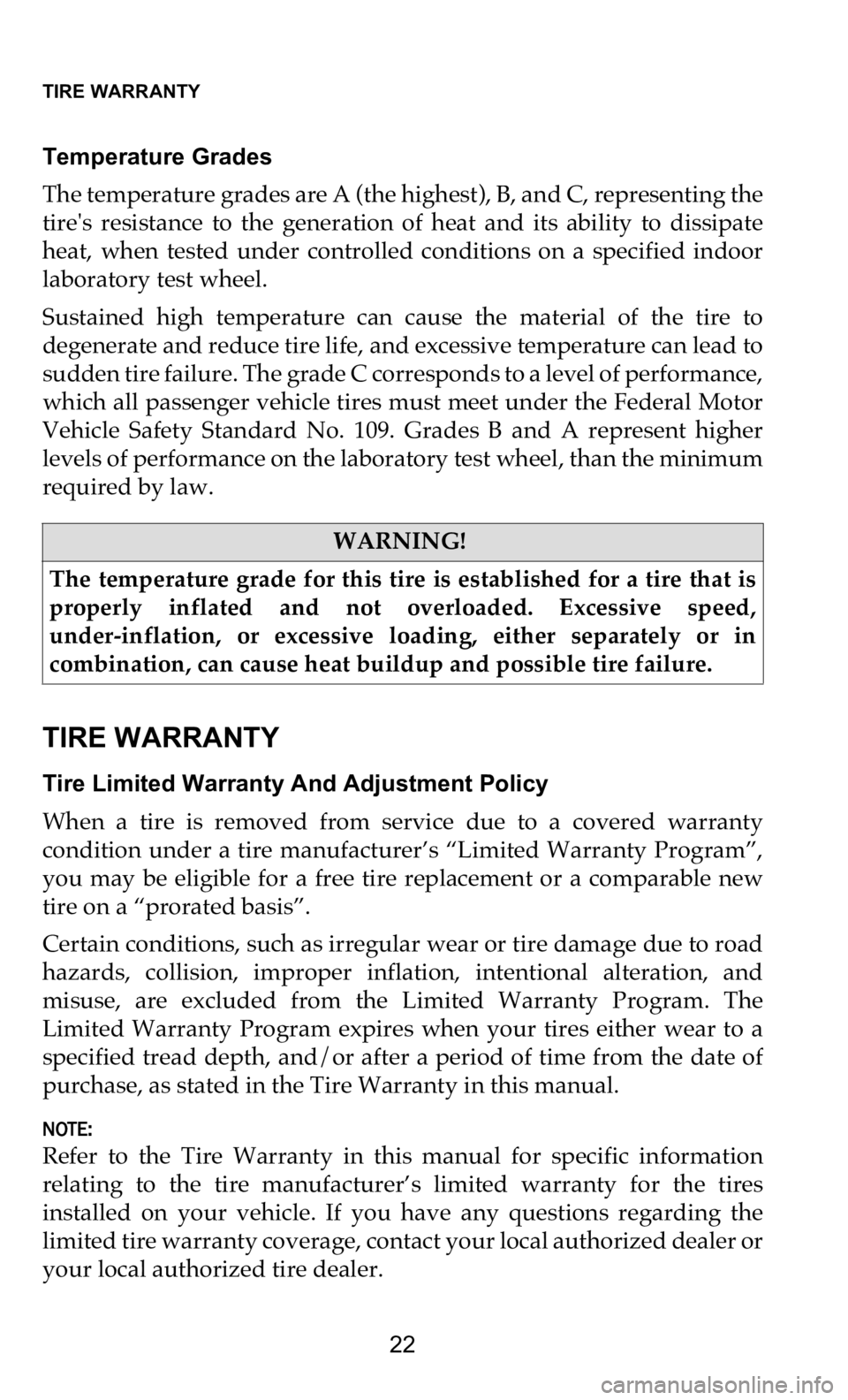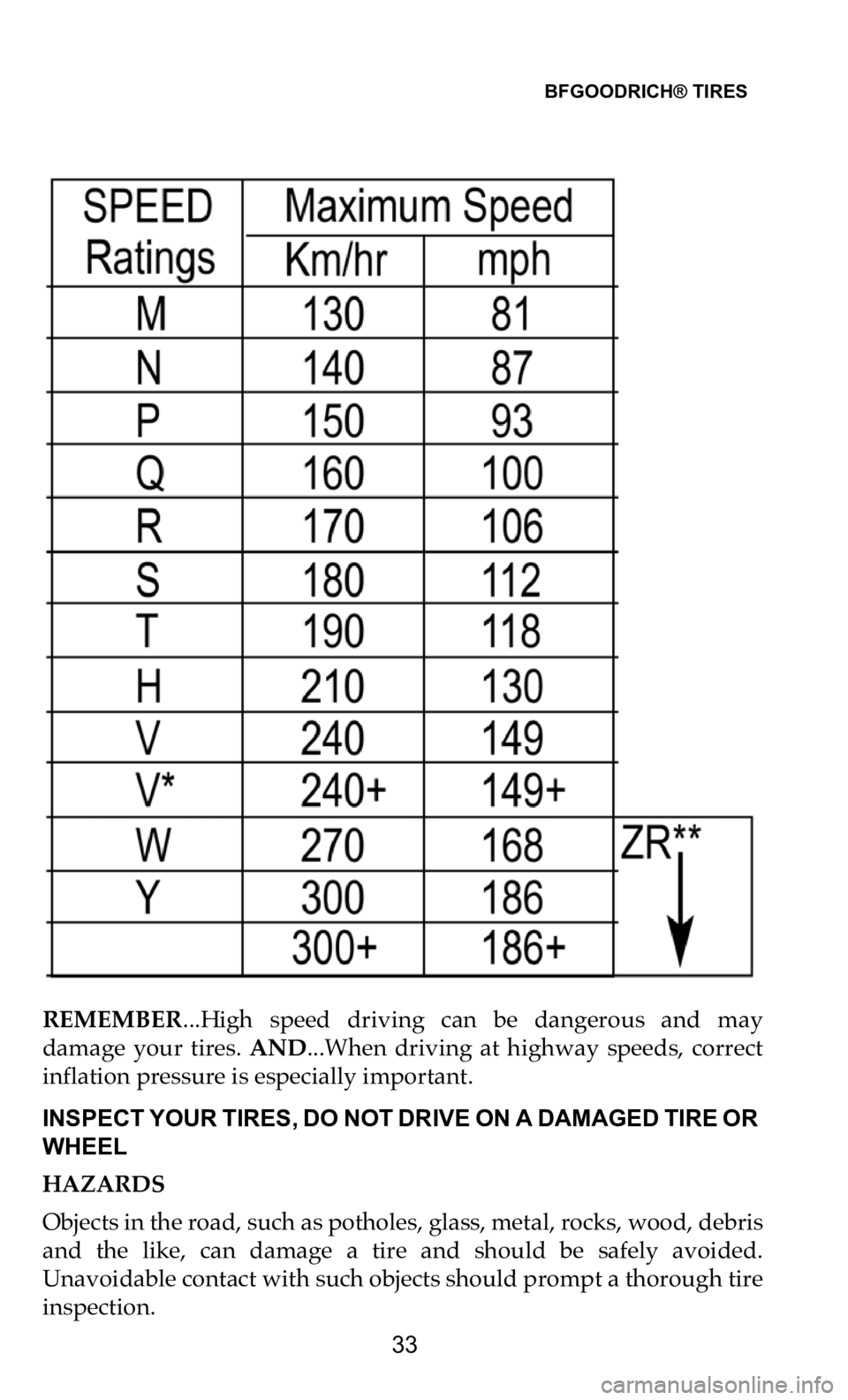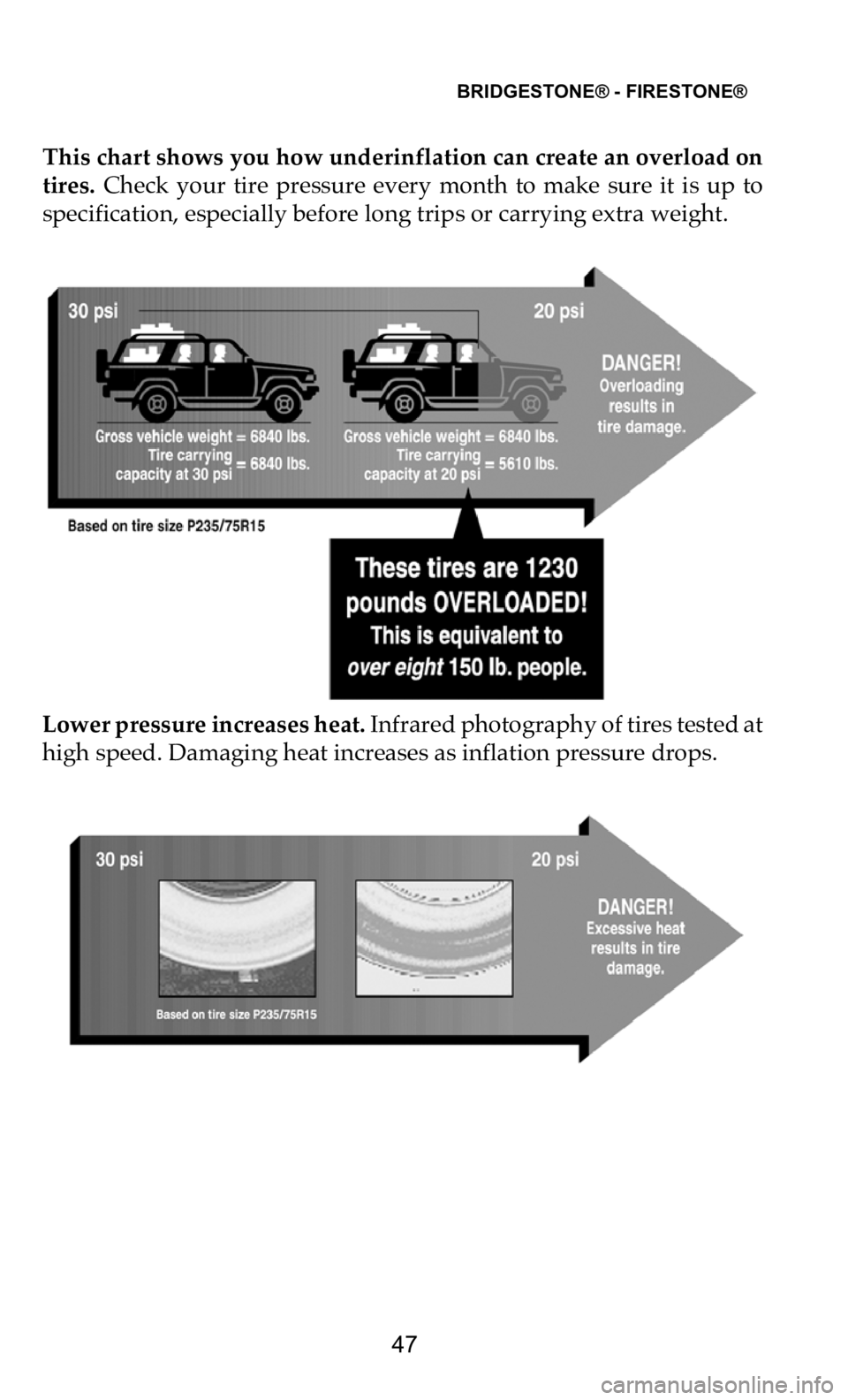ESP DODGE DURANGO 2021 Vehicle Warranty
[x] Cancel search | Manufacturer: DODGE, Model Year: 2021, Model line: DURANGO, Model: DODGE DURANGO 2021Pages: 262, PDF Size: 10.42 MB
Page 4 of 262

TIRES
3
• LT (Light Truck) — Metric tire sizing is based on US design stan -
dards. The size designation for LT-Metric tires is the same as for
P-
Metric tires except for the letters “LT” that are molded into the
sidewall preceding the size designation. Example: LT235/85R16.
• Temporary spare tires are designed for temporary emergency use
o
nly. Temporary high pressure compact spare tires have the letter
“T” or “S” molded into the sidewall preceding the size designation.
Example: T145/80D18 103M.
• High flotation tire sizing is based on US design standards and it
b
egins with the tire diameter molded into the sidewall. Example:
31x10.5 R15 LT.
Tire Sizing Chart
EXAMPLE:
Example Size Designation: P215/65R15XL 95H, 215/65R15 96H, LT235/85R16C,
T1
45/80D18 103M, 31x10.5 R15 LT
P = Passenger car tire size based on U.S. design standards, or
"....blank...." =
Passenger car tire based on European design standards, or
LT = Light Truck tire based on US design standards, or
T
or S = Temporary spare tire or
3
1 = Overall diameter in inches (in)
2
15, 235, 145 =
Section width in millimeters (mm)
65, 85, 80 = Aspect ratio in percent (%)
•
Ratio of section height to section width of tire, or
1
0.5 = Section width in inches (in)
R
= Construction code
• "R" means radial construction, or
•
"D" means diagonal or bias construction
1
5, 16, 18 = Rim diameter in inches (in)
S
ervice Description:
95 = Load Index
•
A numerical code associated with the maximum load a tire can carry
H
= Speed Symbol
• A symbol indicating the range of speeds at which a tire can carry a load corre -
s
ponding to its load index under certain operating conditions
• The maximum speed corresponding to the speed symbol should only be achieved
u
nder specified operating conditions (i.e., tire pressure, vehicle loading, road condi -
tions, and posted speed limits)
Page 11 of 262

TIRES
10
Tires — General Information
Tire Pressure
Proper tire inflation pressure is essential to the safe and satisfactory
op
eration of your vehicle. Four primary areas are affected by
improper tire pressure:
• Safety and Vehicle Stability
•
Economy
•
Tread Wear
•
Ride Comfort
S
afety
Both underinflation and overinflation affect the stability of the vehicle
a n
d can produce a feeling of sluggish response or over responsiveness
in the steering.
NOTE:
• Unequal tire pressures from side to side may cause erratic and
unpredictable steering response.
• Unequal tire pressure from side to side may cause the vehicle to drift
l
eft or right.
WARNING!
• Improperly inflated tires are dangerous and can cause collisions.
•
Underinflation increases tire flexing and can result in over -
h
eating and tire failure.
• Overinflation reduces a tire's ability to cushion shock. Objects
o
n the road and chuckholes can cause damage that result in tire
failure.
• Overinflated or underinflated tires can affect vehicle handling
a
nd can fail suddenly, resulting in loss of vehicle control.
• Unequal tire pressures can cause steering problems. You could
l
ose control of your vehicle.
• Unequal tire pressures from one side of the vehicle to the other
c
an cause the vehicle to drift to the right or left.
• Always drive with each tire inflated to the recommended cold
t
ire inflation pressure.
Page 12 of 262

TIRES
11
Fuel Economy
Underinflated tires will increase tire rolling resistance resulting in
hi
gher fuel consumption.
Tread Wear
Improper cold tire inflation pressures can cause abnormal wear
pa
tterns and reduced tread life, resulting in the need for earlier tire
replacement.
Ride Comfort And Vehicle Stability
Proper tire inflation contributes to a comfortable ride. Overinflation
pr
oduces a jarring and uncomfortable ride.
Tire Inflation Pressures
The proper cold tire inflation pressure is listed on the driver side
B-
pillar or rear edge of the driver side door.
At least once a month:
• Check and adjust tire pressure with a good quality pocket-type
p
ressure gauge. Do not make a visual judgement when determining
proper inflation. Tires may look properly inflated even when they
are under-inflated.
• Inspect tires for signs of tire wear or visible damage.
I
nflation pressures specified on the placard are always “cold tire
in
flation pressure”. Cold tire inflation pressure is defined as the tire
pressure after the vehicle has not been driven for at least three hours,
or driven less than 1 mile (1.6 km) after sitting for a minimum of three
ho
urs. The cold tire inflation pressure must not exceed the maximum
inflation pressure molded into the tire sidewall.
Check tire pressures more often if subject to a wide range of outdoor
te
mperatures, as tire pressures vary with temperature changes.
Tire pressures change by approximately 1 psi (7 kPa) per 12°F (7°C) of
ai
r temperature change. Keep this in mind when checking tire
pressure inside a garage, especially in the Winter. CAUTION!
After inspecting or adjusting the tire pressure, always reinstall the
va
lve stem cap. This will prevent moisture and dirt from entering
the valve stem, which could damage the valve stem.
Page 23 of 262

TIRE WARRANTY
22
Temperature Grades
The temperature grades are A (the highest), B, and C, representing the
ti
re's resistance to the generation of heat and its ability to dissipate
heat, when tested under controlled conditions on a specified indoor
laboratory test wheel.
Sustained high temperature can cause the material of the tire to
de
generate and reduce tire life, and excessive temperature can lead to
sudden tire failure. The grade C corresponds to a level of performance,
which all passenger vehicle tires must meet under the Federal Motor
Vehicle Safety Standard No. 109. Grades B and A represent higher
levels of performance on the laboratory test wheel, than the minimum
required by law.
TIRE WARRANTY
Tire Limited Warranty And Adjustment Policy
When a tire is removed from service due to a covered warranty
co
ndition under a tire manufacturer’s “Limited Warranty Program”,
you may be eligible for a free tire replacement or a comparable new
tire on a “prorated basis”.
Certain conditions, such as irregular wear or tire damage due to road
ha
zards, collision, improper inflation, intentional alteration, and
misuse, are excluded from the Limited Warranty Program. The
Limited Warranty Program expires when your tires either wear to a
specified tread depth, and/or after a period of time from the date of
purchase, as stated in the Tire Warranty in this manual.
NOTE:
Refer to the Tire Warranty in this manual for specific information
re
lating to the tire manufacturer’s limited warranty for the tires
installed on your vehicle. If you have any questions regarding the
limited tire warranty coverage, contact your local authorized dealer or
your local authorized tire dealer.
WARNING!
The temperature grade for this tire is established for a tire that is
pr
operly inflated and not overloaded. Excessive speed,
under-inflation, or excessive loading, either separately or in
combination, can cause heat buildup and possible tire failure.
Page 28 of 262

BFGOODRICH® TIRES
27
WHAT YOU MUST DO WHEN MAKING A CLAIM
When making a claim under the terms of this limited warranty you
mu
st present your tire(s), your vehicle, and your original invoice to a
participating BFGoodrich® brand tire retailer. BFGoodrich® brand
tire retailers are listed in the yellow pages under “Tire Dealers-Retail”.
Personal identification (i.e. Driver’s License, Credit Card, etc.) and
vehicle registration may be required. You pay any service charges for
normal vehicle and tire maintenance.
CONDITIONS AND EXCLUSIONS
This limited warranty does not provide compensation for loss of time,
lo
ss of use of vehicle, inconvenience or incidental or consequential
damages.
Tires presented for claim remain the property of the consumer and
BF
Goodrich® brand accepts no responsibility for loss of, or damage
to, tires which are in the custody or control of a BFGoodrich® tire
retailer for the purpose of inspection for warranty adjustment.
In the event of a disputed claim, the consumer must make the tire
av
ailable for further inspection. Tires accepted for claim become the
property of Michelin North America Inc.
No BFGoodrich® brand representative, employee or retailer has the
au
thority to make or imply any representation, promise or agreement,
which in any way varies from the terms of this limited warranty. This
limited warranty applies only in the United States and Canada.
SAFETY MAINTENANCE INFORMATION
Read your Tire Owner’s Manual, the information on the sidewall of
yo
ur tires, your vehicle Owner’s Manual and vehicle tire information
placard for essential safety and maintenance information.
When service is required:
1. Contact a participating BFGoodrich® tire retailer listed in your
y
ellow pages.
2. If additional assistance is needed in locating a BFGoodrich®
r
etailer, please call or write to the Consumer Care Department
listed in this book.
Page 32 of 262

BFGOODRICH® TIRES
31
TIRE SPINNING
Do not spin wheels in excess of 35 mph (55 km/h) as indicated on the
sp
eedometer. Excessive speed in a free-running, unloaded tire can
cause it to “explode” from centrifugal force. The energy released by
such an explosion is sufficient to cause serious physical injury or
death. Never allow anyone to stand near or behind the spinning tire.
When in mud, sand, snow, ice or other slippery conditions, do not
en
gage in excessive wheel spin. Accelerating the motor excessively,
particularly with automatic transmission vehicles, may cause a drive
tire that has lost traction to spin beyond its speed capability. This is
also true when balancing a drive tire/wheel assembly on the vehicle
using the vehicle engine to spin the tire/wheel assembly.
HIGH SPEED DRIVING CAN BE DANGEROUS
Correct inflation pressure is especially important. H
owever, at high
speeds, even with the correct inflation pressure, a road hazard, for
example is more difficult to avoid and if contact is made, has a greater
chance of causing tire damage than at a lower speed. Moreover,
driving at high speed reduces the reaction time available to avoid
accidents and bring your vehicle to a safe stop.
If you see any damage to a tire or wheel, replace it with the spare at
on
ce and visit a participating BFGoodrich® Tire Retailer.
Exceeding the maximum speeds shown on the following page for each
ty
pe of BFGoodrich® tire will cause the tire to build up excessive heat
which can cause tire damage that could result in sudden tire
destruction and rapid air loss. Failure to control a vehicle when one or
more tires experience a sudden air loss can lead to an accident.
In any case, you should not exceed reasonable speeds as indicated
by
the legal limits and driving conditions.
Page 33 of 262

BFGOODRICH® TIRES
32
SPEED RATINGS
Speed Symbols are shown on the sidewall of some BFGoodrich® tires.
Th
e following table shows the maximum speed corresponding to the
symbol.
*Some V (or VR) rated tires may have a speed capacity greater than
14
9 mph (240 km/h). Consult your participating BFGoodrich® tire
re
tailer for maximum speed rating if your vehicle capability exceeds
this speed.
**Z (or ZR) rated tires are designed to use on cars with maximum
sp
eed capabilities in excess of 149 mph (240 km/h).
W and Y speed ratings are sub-categories of Z.
Consult your BFGoodrich® tire retailer for maximum speed
ca
pabilities.
Although a tire may be speed-rated, we do not endorse the operation
of
any vehicle in an unsafe or unlawful manner. Speed ratings are
based on laboratory tests which relate to performance on the road, but
are not applicable if tires are underinflated, overloaded, worn out,
damaged, altered, improperly repaired, or retreaded. Furthermore, a
tire’s speed rating does not imply that vehicles can be safely driven at
the maximum speed for which the tire is rated, particularly under
adverse road and weather conditions or if the vehicle has unusual
characteristics.
BFGoodrich® highway passenger tires that do not have a speed
s y
mbol on the sidewall have a maximum speed rating of 105 mph
(1
70 km/h). Light truck highway tires that do not have a speed
sy
mbol on the sidewall of the tire have a maximum speed rating of
87 mph (140 km/h).
The speed and other ratings of retreaded tires are assigned by the
re
treader and replace the original manufacturer’s ratings.
NOTE:
In order to maintain the speed capability of the vehicle, replacement
ti
res must have speed ratings equal to or higher than those fitted as
original equipment as indicated on the vehicle tire placard or Owner’s
Manual. If tires with lower speed ratings are fitted, the vehicle’s
handling may be affected and the speed capability of the vehicle will
be lowered to the maximum speed capability of the replacement tires
as indicated in the following table.
Page 34 of 262

BFGOODRICH® TIRES
33
REMEMBER...High speed driving can be dangerous and may
damage your tires. AND...When driving at highway speeds, correct
inflation pressure is especially important.
INSPECT YOUR TIRES, DO NOT DRIVE ON A DAMAGED TIRE OR
WH
EEL
HAZARDS
Objects in the road, such as potholes, glass, metal, rocks, wood, debris
an
d the like, can damage a tire and should be safely avoided.
Unavoidable contact with such objects should prompt a thorough tire
inspection.
Page 37 of 262

BFGOODRICH® TIRES
36
It is especially important to check the vehicle manufacturer’s Owner’s
Manual when mixing, matching or replacing tires on 4 Wheel Drive
(4WD) vehicles, as this may require special precautions.
BFGOODRICH® DOES NOT RECOMMEND MIXING SELF
SU
PPORTING STRUCTURE (SSS) TIRES WITH NON-SSS TIRES
OTHER THAN THE TEMPORARY USE OF THE SPARE TIRE.
WINTER DRIVING
Tires which meet the Rubber Manufacturers Association (RMA)
de
finition of snow tires are marked M/S, M&S. On such tires, this
designation is molded into the sidewall. Tires without this notation
are not recommended for winter driving.
While All-Season tires are designed to provide reliable
performance in some winter conditions, the use of four
wi
nter tires is recommended for optimum perfor -
mance. Tires designated for use in severe winter condi -
tions are marked on at least one sidewall with the letter
“M
” and “S” plus a pictograph of a mountain with a snowflake on it.
TIRE ROTATION AND REPLACEMENT
To obtain maximum tire wear, it may be necessary to rotate your tires.
Re
fer to your vehicle Owner’s Manual for instructions on tire rotation.
If you do not have an Owner‘s Manual for your vehicle, BFGoodrich®
recommends rotating your tires every 6,000 to 8,000 miles (10,000 to
12
,000 km).
Monthly inspection for tire wear is recommended. Your tires should
be
rotated at the first sign of irregular wear, even if it occurs before
6,000 miles (10,000 km). This is true for all vehicles.
When rotating tires with a directional tread pattern, observe the
ar
rows molded on the sidewall which show the direction the tire
should turn. Care must be taken to maintain the proper turning
direction.
Some Tire Pressure Monitoring Systems (TPMS) may not recognize
th
at a tire has been moved to a different position on your vehicle.
Make certain that your TPMS system is reset, if necessary, so as to
correctly identify the location of each tire on your vehicle. Refer to
your vehicle Owner’s Manual or your vehicle dealer.
Determine whether rotated tires require tire inflation adjustment as
fr
ont and rear position tire pressure may vary according to the vehicle
Page 48 of 262

BRIDGESTONE® - FIRESTONE®
47
This chart shows you how underinflation can create an overload on
tires. Check your tire pressure every month to make sure it is up to
specification, especially before long trips or carrying extra weight.
Lower pressure increases heat. I
nfrared photography of tires tested at
high speed. Damaging heat increases as inflation pressure drops.